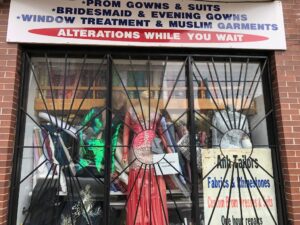 Philadelphia is one of those cities that still have neighborhoods defined by trade. We have the famous Jewelers’ Row off 8th Street, although some stores have been demolished to make room for a high-rise condominium. Never mind that its construction has been stalled due to the pandemic, leaving an ugly open wound fenced by barbwire. It seems that Fabric Row along 4th Street, between Bainbridge and Catherine, has fared a lot better in its transition to gentrification.
Philadelphia is one of those cities that still have neighborhoods defined by trade. We have the famous Jewelers’ Row off 8th Street, although some stores have been demolished to make room for a high-rise condominium. Never mind that its construction has been stalled due to the pandemic, leaving an ugly open wound fenced by barbwire. It seems that Fabric Row along 4th Street, between Bainbridge and Catherine, has fared a lot better in its transition to gentrification.
Fabric Row is over a hundred years old, started by Jewish immigrants who sold textiles and dry goods in curbside pushcarts. Eventually, they settled there, building rowhouses with their own storefronts. On a recent visit, I noticed that there were fewer and fewer fabric stores and more trendy boutiques, with some restaurants and tattoo parlors.
Growing up in Madrid I was aware that there were certain parts of the city well demarcated by its stores too. One had to go between Puerta del Sol and Plaza Mayor to look for religious holiday decorations, and Nativity sets, something that my family was not really into. My mother and I would go to Pontejos, a small, not-well-known plaza nearby, to look for fabrics and “mercerías” a word that isn’t used anymore, like its counterpart in English: “sewing notions.”
There were a set of traditions and rituals around sewing clothes in my family. Almost every week a “costurera,” (a seamstress) would come to make sheets, kitchen linens and children’s clothes. She would sit at the Singer machine in the family room, making a racket all day. My mother kept an eye on her while she embroidered initials and put the finishing touches on our garments. But when my mother needed a dress or a suit, she would go to Pontejos first to find the appropriate fabric. Then, she went to a dressmaker on fancy General Mola Street (Príncipe de Vergara since Franco died, when the streets were renamed back to their original names). I often accompanied her on those expeditions to the dressmaker. There were catalogs with patterns, fabric swatches and full-length mirrors everywhere. I liked sitting on a low stool and playing with the marking chalk and the colorful pins.
I remember an expression that defined how we dressed in those times. It was to have “quita y pon,” one piece to take off and one to put on. Thus, I had two uniforms, two pajamas, two Sunday dresses and so on; one to wear, while the other was being washed. There were all sorts of transformations too. My mother’s dress would turn into a skirt for me; her sundress would become an apron for the cleaning woman. My father’s trousers and jackets converted into a suit for my brother while he still wore short pants.
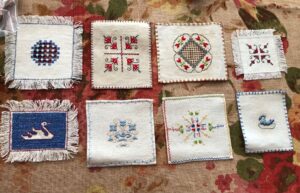 I learned to sew in school. I have kept the cross-stich samples and many other fancy embroideries I made as a child. My favorite project was to make a “canastilla,” a complete set of clothes for the baby –notice how we were being indoctrinated to be perfect housewives and mothers! I have to admit that all this sewing came in handy when I was a Marine Corps wife. For years I made all my clothes and my daughters’ as well. I even ventured with a formal gown for the Marine Corps Ball and silk ties as Christmas gifts, a tricky task.
I learned to sew in school. I have kept the cross-stich samples and many other fancy embroideries I made as a child. My favorite project was to make a “canastilla,” a complete set of clothes for the baby –notice how we were being indoctrinated to be perfect housewives and mothers! I have to admit that all this sewing came in handy when I was a Marine Corps wife. For years I made all my clothes and my daughters’ as well. I even ventured with a formal gown for the Marine Corps Ball and silk ties as Christmas gifts, a tricky task.
Now I go to Fabric Row in Philadelphia to look for upholstery fabrics. Occasionally, I make table linens or buy fancy buttons, another fetish of mine. This last time I met an old friend for lunch, Marisol, who lives in that neighborhood. It was a rainy fall day full of nostalgia.

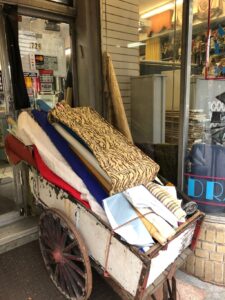

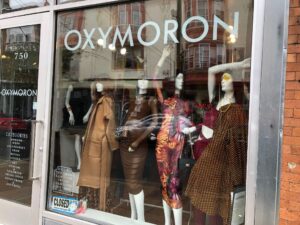
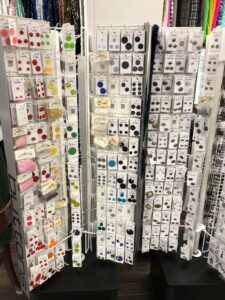

Once again my dear friend, Concha, has painted, in primary colors, a neighborhood of Philadelphia.
She is the close observer. Noticing details that a casual stroller would usually miss.
Clearly, she cares for the city and enjoys its sundry wonders.
I feel that, too often, I focus on the negative and miss the positive.
It’s helpful to me to be able to see these sites through her eyes and descriptions.
So glad I can open your eyes to the wonders of Philly, a trove of colors and sounds for a photographer and a poet like you, Concha
What a beautiful recollection. Life in the States was so different from Europe in the post war years.
As for the trade districts (and ethnic neighborhoods), Philly is lucky to still have them. The fabric of the city, so to speak.
Thanks so much, Elayne. We are on the same page, Concha
This is a terrific story, Concha. It brought back fond memories. My father and siblings came to Philadelphia in 1920. Uncle Charlie had a pleating factory around 3rd and Arch, and Uncle Jules had a dry goods store of 3rd Street. We got socks and underwear from him. I’m going to send this writing to my cousins. Keep writing. Herman
“A pleating factory,” who knew? Such a small world!
Concha, your piece is absolutely delightful! I see we have much more to talk about next Monday. xo Susan
Looking forward to catching up, Concha
You captured our old neighborhood beautifully, Concha. I enjoyed every word and the accompanying photos too. The streetscape has changed, but it is still interesting and fun!
Ramona
And I love your comments, Ramona!
This one post has given me more comments than any other before. Who would have known that Fabric Row was so dear to people’s hearts!
Thanks one and all, Concha
Again, your words stirred my thoughts as I reflected on the “fabrics” of life literally, as I have known and worn and felt them in each stage of my life. It was an interesting retrospective trip but one that people hardly think about as having relevance to who they have become; how they were made or crafted as clothes and by whom or ones first dress or pair of pants bought for a special occasion or a coat given in the service of someone’s need only to see it altered to fit a third cousins young child in Italy. Even the new born infant must be seen as more than a bundle of primary processes wrapped in a cotton diaper! After all, our skin has the largest number of receptors in our body and therefore truly “knows” the meaning of a sensate experience.
Dick, you made me think of how my First Communion dress turned into a Sunday dress and much more…
Many thanks for engaging so well, Concha
Love this post, dear Concha. Going to Fabric Row has been part off my life as far back as I can remember. I especially like the findings stores, where I muse about who will buy all those sequins; and on what ball gown or Mummer’s costume they will be sewn. The store owners are kind to me, knowing that I have a passion for design and texture, rarely spending much money, they always find time to chat.
Cirel Magen
I’m so glad to hear, Cirel. We’ve had similar experiences. This last time, when I asked about the Mummers, they told me that they don’t buy from them anymore. They have deliveries to their back doors, whatever that means…
Love, Concha